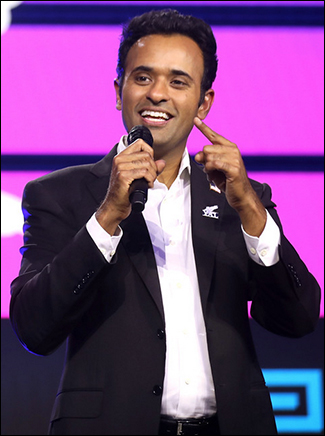By Jim Ellis — Tuesday, Feb. 25, 2025
Governor

Republican Vivek Ramaswamy / Photo by Gage Skidmore
The Republican primary race already appears to be evolving into a two-way battle between Ramaswamy, leading in all early nomination campaign polling, and two-term Attorney General Dave Yost.
A newly released Yost campaign survey, however, suggests the race could eventually tighten, and that an endorsement from President Donald Trump for one of the candidates could prove determinative. Yesterday, the President gave Ramaswamy his “complete and total endorsement.”
The National Public Affairs polling organization conducted an early February Ohio survey for the Yost campaign (Feb. 2-5; 602 likely Ohio Republican primary voters; live interview and text) and, like other research studies, found Ramaswamy posting a major lead, 46-18 percent.
Earlier, WPA Intelligence (Jan. 28-30; 600 likely Ohio Republican primary voters) saw Ramaswamy holding a 57-28 percent advantage over Yost. The Fabrizio Lee & Associates firm also tested the state in late January (Jan. 26-27; 600 likely Ohio Republican primary voters) and projected the Ohio entrepreneur topping AG Yost with a 52-18 percent margin while the since withdrawn State Treasurer Robert Sprague posted two percent preference. (Mr. Sprague, term-limited in the coming election as Ohio’s Treasurer, quickly dropped out of the Governor’s race and instead entered the open Secretary of State’s contest endorsing Ramaswamy as he exited.)
While all of the released public polls basically arrive at the same conclusion, NPA provided further information in their survey analysis that attempts to cast the largely uniform results in a different political light.
According to NPA partner Justin Clark, “our findings indicate that this early advantage is a ‘sugar high’ driven by a pre-inauguration media saturation that led to high name ID and perceived association with President Trump. That said, even at this high point of public opinion, polling support for Ramaswamy is incredibly soft. Beyond the temporal component of his losing the “sugar high” after quitting the Trump administration before it even started, the survey is clear that voters align closest to the candidate that receives the backing of President Trump … whoever that candidate is.”
We now know who Trump will endorse and it’s Ramaswamy. The Yost pollsters clearly understand the impact of presidential support in the Republican primary as their polling analysis explains.
After a series of unreleased push questions that constituted what NPA described as the “informed ballot” brought Yost within one point of Ramaswamy, the horse race question was then asked to determine what effect Trump endorsing the Attorney General would have on the primary election. If such were the case, Yost would pull ahead of Ramaswamy, 42-22 percent; hence, the power of an early Trump endorsement.
In terms of the favorability index, President Trump maintains an 82-16 percent positive to negative ratio and Vice President and former Ohio Sen. J.D. Vance scores an almost identical 81:16 percent. Ramaswamy posts a 64:15 percent score, which is better than newly elected Sen. Bernie Moreno (65:22 percent), and Attorney General Yost (53:14 percent), though all the sampled Republican primary voters viewed each tested figure very favorably.
Clearly, Ramaswamy wants to deliver an early knockout blow, and it appears he has the assets to make that happen. With a big lead in early polling and, as of yesterday, Trump’s endorsement, it appears the former presidential candidate has the package he needs to secure the Republican nomination. With that, he will have the inside track for the general election in a state that is trending more Republican.
The only Democrat to so far announce for Governor is former Ohio Health Department director Amy Acton. Other, and likely stronger, potential candidates are waiting in the wings. It is unclear if any or all of the following would make a gubernatorial run, but some from this group are likely to try.
Those Democrats mentioned as considering a bid for Governor are: former Senator Sherrod Brown, Cincinnati Mayor Aftab Pureval, Cleveland Mayor Justin Bibb, Columbus Mayor Andy Ginther, state Supreme Court Justice and former Secretary of State Jennifer Brunner, and former Congressman, 2016 presidential candidate, and 2022 US Senate nominee Tim Ryan.






